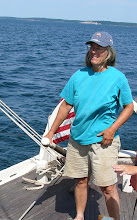
HOW How To Help Our Water by Conserving It
This is the fourth in our HOW Helping Our Water series, published in several local media that expands upon items from Sid's list (first published in my book Twinkle Toes and the Riddle of the Lake).This one is posted with a nod to arid southern California where the author is now visiting. Item number 7 from Sid's list is Save Water and the photo shows what southern California looks like without input from the Colorado River.
So why should we who live near a freshwater sea worry about saving water? Unlike San Diego with annual rain falls of 8 inches a year, don't we have lots? Yes, but when we use it, it gets DIRTY. Since the dawn of time dilution has been the solution to pollution. But Earth now supports 7 billion people, and that “solution” just isn't working too good anymore.
Somehow, I have long found the logic of drinking water and then crapping in the same water supply a bit offensive, if not downright deluded. Increasingly, others agree. This was made clear at the 2010 Annual World Toilet Summit, the biggest yet, held in Philadelphia last fall.
As several participants at this year's trade fair and technology showcase for plumbers noted, the U.S. with its regionally abundant water supplies lags far behind China, Europe and even the so called Third World when it comes to adopting more efficient toilet technology. We're still stuck with our mindset of disposing of human crap by treating it with chemicals to kill pathogens and then dumping it in our drinking water. However, groups like PHLUSH (Public Hygiene Lets Us Stay Human) and the WTO ( That's World Toilet Organization, now active in 58 countries, NOT the global money men) are trying hard to make friends and influence people on behalf of the waterless toilet.
These toilets have improved dramatically since the 1970's. I personally know three people with composting toilets who are quite satisfied with them and can testify there was no more smell associated with their use than with a conventional set up. And they're simple to install too, no pricey septic system required! You can even get them for marine and RV use.
If you can't swallow the price tag for one aboard the boat or stomach the idea of a waterless toilet in your house, then at least spring for a low flush model if you haven't already got one or put a brick in the toilet tank of your old dinosaur.
While the the toilet and flushing same is one of the biggest household users of water, a lot also goes down the tub and shower drain. The Minnesota extension service website estimates 75% of the typical 260 gallons a day used by a household of 4 goes down bathroom drains or toilet thanks to lavish and frequent baths and showers. Admittedly, a leisurely long soak in the tub is a great stress reducer, but there are good reasons to NOT bathe every day.
Too much bathing can dry the skin causing itching and discomfort. And recent research shows it also totally messes up the intricate balance of our skin's 'ecosystem' of bacteria. The 'good' bacteria present on our skin help us stay healthy so it's very much in our interest to not wash them all down the drain every day. Dr. Richard Gallo of San Diego's UCSD studies healing and wound repair. He has found our skin makes natural antibiotics that reduce skin infection, and that some of our skin bacteria actually fight pathogenic bacteria like the infamous Staph aureus of hospital fame.
Less frequent hot water baths save energy, too. Less electricity use directly impacts Lake Ontario, home to a whole fleet of power plants- all of which use water to cool their turbines, cooking a whole lot of plankton and adding still more chemicals to the lake in the process. Low flow shower heads and shallower baths in the tub help, too.
Along with numerous daily showers and toilet flushes, the other big area for household water savings is irrigation. As written about previously in the lawn care column, good soil with lots of organic content and appropriate grass plantings can help your lawn withstand dry spells. Mulch the flowers and vegetables, too. If you do water the lawn and garden, follow practices like morning irrigation and water deeply to encourage root growth. Sometimes, you can water those special dry areas of the lawn by hand. And by all means, start up an old fashioned rain barrel.
There are many good websites on water conservation.check out eartheasy.com for water saving tips in house and yard
composting toilets- http://www.comparethebrands.com/compare/134
